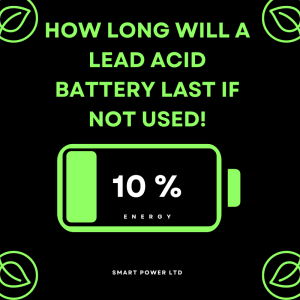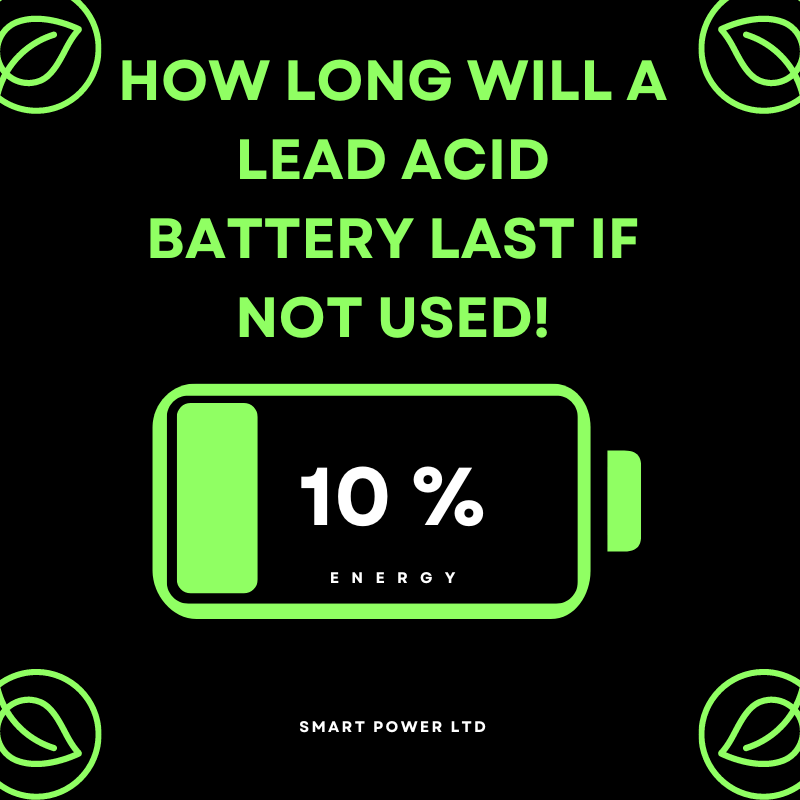A sealed lead acid battery can generally sit on a shelf at room temperature with no charging for up to a year when at full capacity. However, this depends on the battery’s condition and surroundings.
Lead acid batteries are known for their solidness and capacity to endure outrageous temperatures. They are often used in cars, motorcycles, and emergency backup systems. However, when not in use, these batteries can lose their charge and slowly deteriorate over time.
This can lead to reduced capacity, high internal resistance, or complete failure. We will explore how long a lead acid battery can last without use and what factors can affect its lifespan. Whether you’re storing a battery for winter or just need to know how to keep it in top shape, this guide will give you the information you need.
How Long Will A Lead Acid Battery Be OK That Is Not Used?
A lead acid battery has a limited shelf life, even if it is not being used. The shelf life of a Sealed Lead Acid (SLA) battery is about a year at full capacity when stored at room temperature without charging. Flooded lead acid batteries have a shorter shelf life of six months or less. However, the lifespan of a lead acid battery can be extended through proper maintenance and occasional charging. Car batteries can last up to six months without driving, but it’s recommended to start the car at least once a week to maintain a healthy battery. Attempting to revive a dried out lead acid battery is difficult and unlikely to be successful. It’s important to store lead acid batteries properly to prevent any damage that might affect their overall lifespan.
Lead Acid Battery Shelf Life: | SLA battery – 1 year | Flooded lead acid battery – 6 months or less |
Lifespan of a Lead Acid Battery: | Extended through proper maintenance and occasional charging |
|
How Long a Car Battery Lasts Without Driving: | Up to 6 months |
|
Factors Affecting Lead Acid Battery Lifespan
The lifespan of a lead acid battery can be affected by several factors when not in use, such as temperature, state of charge, and self-discharge rate. A fully charged SLA (sealed lead-acid) battery can generally sit on a shelf at room temperature without charging for up to a year, but prolonged storage without recharging can lead to reduced capacity and internal resistance.
Proper maintenance and charging can help prolong the life of a lead acid battery.
Factors Affecting Lead Acid Battery Lifespan
However, some factors can affect their lifespan when not in use. Temperature is a critical factor in determining the longevity of lead-acid batteries. Age is another factor that affects battery life. The older the battery, the more likely it is to fail. Overcharging is also a common problem that can reduce the life of the battery. When it comes to lead-acid batteries, it is essential to keep them properly charged and avoid overcharging them. By taking care of these factors, you can extend the life of your lead acid battery even when not in use. |
Best Practices For Storing Unused Lead Acid Batteries
Lead acid batteries tend to deteriorate over time if not used properly. To make them last longer, it’s important to store them properly. Keep them in a dry and cool location, charge them every 6 months, and never exceed the recommended voltage.
By following these best practices, you can prolong the lifespan of your unused lead acid batteries.
Lead-acid batteries can last for a long time if they are stored properly when not in use. Before storing, charge the batteries to full capacity using a good quality battery charger. The batteries should be stored in a cool and dry place, away from direct sunlight and heat sources. Regular maintenance is crucial to extend their lifespan. Check the battery voltage and top up the electrolyte level periodically if needed. The batteries should also be discharged and recharged occasionally to prevent sulfation. A fully charged sealed lead-acid battery can sit on a shelf at room temperature for up to a year without the need for charging. It is important to note that a dried-out lead-acid battery cannot be revived, even with pulsed charging. Proper charging before storage, storage conditions, and regular maintenance are the key to extending the lifespan of a lead-acid battery.
Conclusion
To sum up, lead acid batteries can last up to a year when not in use, depending on the type and storage conditions. However, the longer they sit unused, the more they deteriorate, reducing their capacity and internal resistance. While there are chargers and methods that claim to revive dead batteries, a totally dead battery is difficult to revive.
Therefore, it’s best to keep batteries charged and regularly maintained to ensure their optimal lifespan and performance.
Frequently Asked Questions
While there are chargers that claim to revive dead lead acid batteries by pulsed charging, complete success is unlikely. Even if you can put some charge back into the battery, it’ll likely still be severely damaged, with reduced capacity and high internal resistance.
It’s better to properly maintain and store lead-acid batteries to prolong their lifespan instead.
A lead acid battery can last up to 10 years if properly maintained and used frequently. However, if the battery is not used for an extended period, it may lose capacity and could become severely damaged. It’s important to use a pulse charger for reviving dead batteries and to store unused batteries in a cool, dry place.
According to BatteryGuy, a Sealed Lead Acid battery can generally sit on a shelf at room temperature with no charging for up to a year when at full capacity.
A sealed lead acid battery can stay on the shelf for up to one year when fully charged and unused. However, the battery lifespan naturally degrades with time and may eventually break down, even with proper charging and usage.

Top 10 Uninterrupted Power Supply (UPS) Brand in Bangladesh
Table of Contents The top 10 uninterrupted power supply (UPS) brands in Bangladesh are APC by Schneider Electric, Luminous, Genus Power, Microtek, Amaron, Eaton Corporation

Best Mini IPS for Power Cutting Solution Price in Bangladesh
Table of Contents For the best mini IPS for power cutting solution price in Bangladesh, there are various options such as DSP IPS, Rahimafrooz IPS,

How Long Will a Lead Acid Battery Last if not Used!
Table of Contents A sealed lead acid battery can generally sit on a shelf at room temperature with no charging for up to a year

